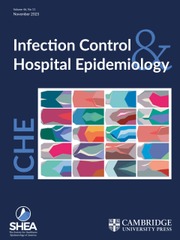Crossref Citations
This article has been cited by the following publications. This list is generated based on data provided by
Crossref.
Farr, Barry M.
2006.
Doing The Right Thing (and Figuring Out What That Is).
Infection Control & Hospital Epidemiology,
Vol. 27,
Issue. 10,
p.
999.
Kluytmans, Jan
2007.
Control of meticillin-resistant Staphylococcus aureus (MRSA) and the value of rapid tests.
Journal of Hospital Infection,
Vol. 65,
Issue. ,
p.
100.
Farr, Barry M.
2007.
Political Versus Epidemiological Correctness.
Infection Control & Hospital Epidemiology,
Vol. 28,
Issue. 05,
p.
589.
Dunlap, John Travis
2007.
Methicillin-Resistant Staphylococcus aureus in Critical Care Areas.
Critical Care Nursing Clinics of North America,
Vol. 19,
Issue. 1,
p.
61.
Pavlov, I.
2007.
High Colonization Pressure Might Compromise the Efficiency of Routine Methicillin-Resistant Staphylococcus aureus Screening.
Clinical Infectious Diseases,
Vol. 44,
Issue. 5,
p.
766.
Batra, Rahul
Eziefula, Alice C.
Wyncoll, Duncan
and
Edgeworth, Jonathan
2008.
Throat and rectal swabs may have an important role in MRSA screening of critically ill patients.
Intensive Care Medicine,
Vol. 34,
Issue. 9,
p.
1703.
Carey, Alison J.
Saiman, Lisa
and
Polin, Richard A.
2008.
Hospital-Acquired Infections in the NICU: Epidemiology for the New Millennium.
Clinics in Perinatology,
Vol. 35,
Issue. 1,
p.
223.
Moalla, M.
Baratin, D.
Giard, M.
and
Vanhems, P.
2008.
Incidence of Methicillin-Resistant Staphylococcus aureus Nosocomial Infections in Intensive Care Units in Lyon University Hospitals, France, 2003-2006.
Infection Control & Hospital Epidemiology,
Vol. 29,
Issue. 5,
p.
454.
Humphreys, H.
2008.
Can we do better in controlling and preventing methicillin-resistant Staphylococcus aureus (MRSA) in the intensive care unit (ICU)?.
European Journal of Clinical Microbiology & Infectious Diseases,
Vol. 27,
Issue. 6,
p.
409.
McQuillen, Daniel P.
Petrak, Russell M.
Wasserman, Ronald B.
Nahass, Ronald G.
Scull, Jason A.
and
Martinelli, Lawrence P.
2008.
The Value of Infectious Diseases Specialists: Non–Patient Care Activities.
Clinical Infectious Diseases,
Vol. 47,
Issue. 8,
p.
1051.
Chaberny, I. F.
Schwab, F.
Ziesing, S.
Suerbaum, S.
and
Gastmeier, P.
2008.
Impact of routine surgical ward and intensive care unit admission surveillance cultures on hospital-wide nosocomial methicillin-resistant Staphylococcus aureus infections in a university hospital: an interrupted time-series analysis.
Journal of Antimicrobial Chemotherapy,
Vol. 62,
Issue. 6,
p.
1422.
Robicsek, Ari
Beaumont, Jennifer L.
Paule, Suzanne M.
Hacek, Donna M.
Thomson, Richard B.
Kaul, Karen L.
King, Peggy
and
Peterson, Lance R.
2008.
Universal Surveillance for Methicillin-Resistant Staphylococcus aureus in 3 Affiliated Hospitals.
Annals of Internal Medicine,
Vol. 148,
Issue. 6,
p.
409.
Sarda, Vanessa
Molloy, Anne
Kadkol, Shirahi
Janda, William M.
Hershow, Ronald
and
McGuinn, Marcella
2009.
Active Surveillance for Methicillin-Resistant Staphylococcus aureus in the Neonatal Intensive Care Unit.
Infection Control & Hospital Epidemiology,
Vol. 30,
Issue. 9,
p.
854.
Schulz, Marten
Nonnenmacher, Claudia
and
Mutters, Reinier
2009.
Cost-effectiveness of rapid MRSA screening in surgical patients.
European Journal of Clinical Microbiology & Infectious Diseases,
Vol. 28,
Issue. 11,
p.
1291.
Humphreys, H.
2009.
Do guidelines for the prevention and control of methicillin-resistant Staphylococcus aureus make a difference?.
Clinical Microbiology and Infection,
Vol. 15,
Issue. ,
p.
39.
Spence, Michael R.
Courser, Shari
and
Dammel, Tereal
2009.
Polymerase chain reaction screening for methicillin-resistant Staphylococcus aureus and contact isolation.
American Journal of Infection Control,
Vol. 37,
Issue. 7,
p.
601.
Willemse-Erix, Diana F. M.
Scholtes-Timmerman, Maarten J.
Jachtenberg, Jan-Willem
van Leeuwen, Willem B.
Horst-Kreft, Deborah
Bakker Schut, Tom C.
Deurenberg, Ruud H.
Puppels, Gerwin J.
van Belkum, Alex
Vos, Margreet C.
and
Maquelin, Kees
2009.
Optical Fingerprinting in Bacterial Epidemiology: Raman Spectroscopy as a Real-Time Typing Method.
Journal of Clinical Microbiology,
Vol. 47,
Issue. 3,
p.
652.
Tacconelli, E.
2009.
Methicillin-resistant Staphylococcus aureus: source control and surveillance organization.
Clinical Microbiology and Infection,
Vol. 15,
Issue. ,
p.
31.
Kang, Jiyeon
Cho, Jinwan
Kim, Yujung
Kim, Dong-Hee
Lee, Jiyoung
Park, Hey-Kyung
Jung, Sung-Hee
and
Lee, Eun-Nam
2009.
Hospital Nurses' Knowledge and Compliance on Multidrug-resistant Organism Infection Control Guideline.
Journal of Korean Academy of Nursing,
Vol. 39,
Issue. 2,
p.
186.
Tacconelli, E.
2009.
Screening and isolation for infection control.
Journal of Hospital Infection,
Vol. 73,
Issue. 4,
p.
371.

